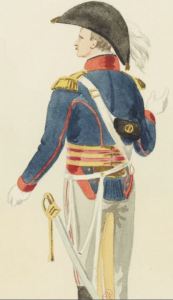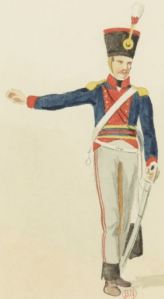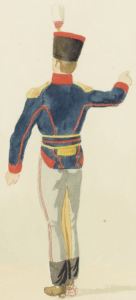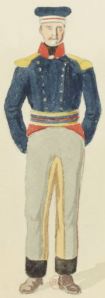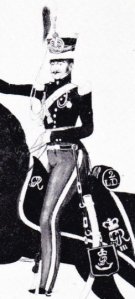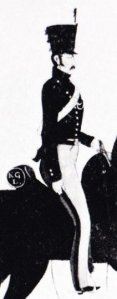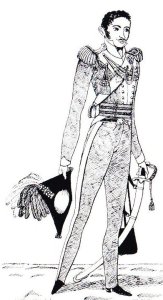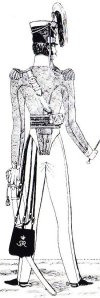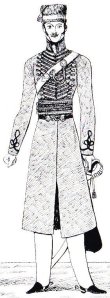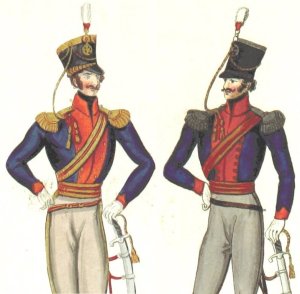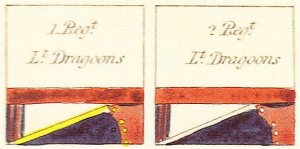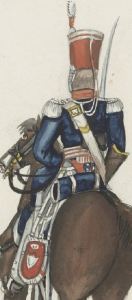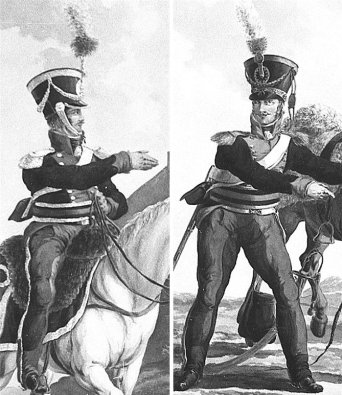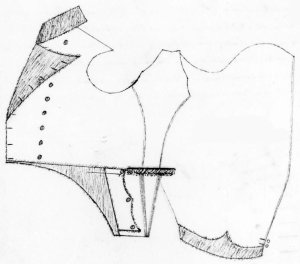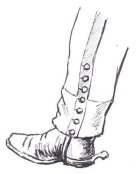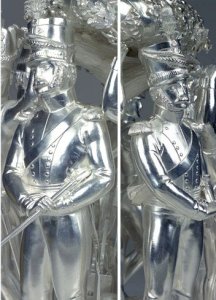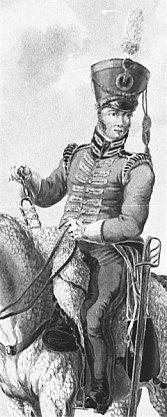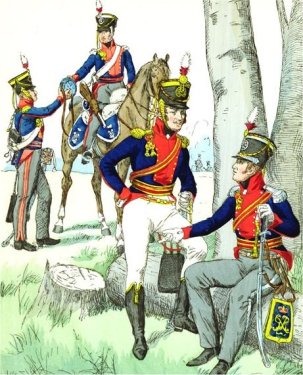(Note: this page extensively revised October 2017)
Given that the two “heavy” dragoon regiments of the Legion (see page 9) were not converted to light dragoons until late 1813, and were then to wear the standard British light dragoon uniform of late 1811, documenting their dress should be straightforward, but it ain’t entirely so, and period evidence is variable on some points. For this topic it may be more helpful to consider the officers’ and men’s dress together. (Sources mentioned are mostly documented on page 1. Click to enlarge images.)
Primary sources
The Beamish plates and Centrepiece, the Hamilton Smith chart, the Meyer ledger and five paintings by Langendijk once again provide first hand evidence. The Meyer ledger (thanks to Meyer & Mortimer and Ben Townsend for access to images) contains accounts for seven officers of the First and five of the Second from late 1813 to early 1816, but mostly from 1814. Compared to earlier entries, the descriptions are generalised and brief, so there is relatively little detail. Even so, this source should be taken into account.
In addition to these, four contemporary, or near contemporary sketches of an officer and men of the First by Jean-Baptiste Rubens are in the Bibliothèque Royale in Brussels, and copies of these by Winand Aerts are in an album at the Bibliothèque Nationale in Paris. Rubens labelled these as Hanoverian artillery, but they are clearly light dragoons, as re-identified by Aerts. As photos of the four original Rubens sketches are currently absent from the records at Brussels, I am using the Aerts versions here.
- Officer of the First by Aerts, after Rubens
- Private
- Private, undress
These show some odd features; without the originals for comparison we have to assume that Aerts copied them faithfully. The officer is identified by his girdle, gloves and rarely seen cocked hat (also in the von Hugo full dress image for the Second – see below); however, he wears the belts of an enlisted man. The cap shown in two images of a private appears peakless, and has no cords but has a band in the facing colour, rather than in yellow. Other features will be commented on below.
For the Second, we have six excellent images of officers in various orders of dress by Lieutenant Ludolph von Hugo of that regiment at the Historisches Museum am Hohen Ufer, Hannover. Photos of two of these, and drawings after them of the remaining four, are available in John Mollo’s Waterloo Uniforms of 1973. Mollo’s photos show review and marching orders, and his drawings full dress, common dress, common drill dress and summer dress. (The figure in marching order, with cap and feather covers and with the jacket buttoned across, is copied directly by Herbert Knötel in a plate for the Elting Napoleonic picture book.)
- Officer of the Second in review order, by von Hugo
- Officer in marching order
- Common dress
- Summer dress
The discussion that follows looks at various aspects individually, and assumes a general background knowledge of the dress of light dragoons post-1811.
Facing colours
An immediate query is the facing colour of the two regiments. The Hamilton Smith chart shows both as a mid red, the only visible difference being the yellow/gold lace/metal for the First and white/silver for the Second. However, on this occasion it’s possible that Colnaghi’s colourists were not quite up to registering the necessary subtleties of shade, for the Beamish plates, both of officers, show scarlet facings for the First and a distinctly more ruby shade for the Second. This is backed up by the earlier Langendijk paintings in the Royal Collection of officers and men of each regiment; these have been published, if at all, only in black and white, but Miller and Dawnay’s colour notes for them describe the facings consistently as “scarlet” for the First and “crimson” for the Second, and a slight difference does seem to show in colour photos of these paintings, which I’m unable to publish here.
If this distinction is accurate, it has escaped the notice of every subsequent uniformologist, from Knötel onwards; all give scarlet for officers and red for men for both regiments, but this has at least to be questioned.
Hats and caps
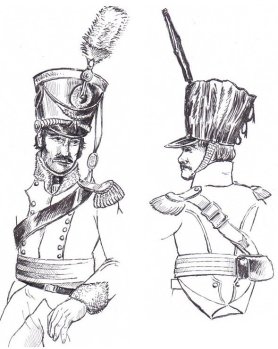
Officer, in pelisse, and private of the Second, after Langendijk. The private’s jacket skirts appear to be wrongly shown.
As already noted, the von Hugo image above of an officer of the Second in full or court dress shows the cocked hat in use, while the Rubens/Aerts image of an officer of the First shows this worn, unusually, in a less formal order of dress. The hat has a gilt star loop, with a red and white drooping plume. (In the Aerts image, the red is hidden behind the hat.)
The von Hugo images for the Second show the officer’s cap with two forms of plume: conventionally upright (in marching order) and drooping (in review and common dress orders). The drooping plume is unusual, and could be a distinction of the KGL or of this regiment. Von Hugo’s image of an officer in common dress shows well the “false peak” on the reverse of the cap.
The Langendijk paintings of an officer and private of the First (below) show their caps as black with gold trim (presumably intended as yellow for the private) with the exception of the private’s chin scales, which are shown as white metal. For the Second (right), Langendijk shows the officer’s cap as black with all silver trim except for the “wheel”, chin straps and peak edge, all shown as gilt. (The cap and feather of Langendijk’s private of the Second are shown in their waterproof covers.)
As noted in passing above, the Rubens/Aerts private’s cap of the First appears peakless, has no cords and has a red band, rather than the orthodox yellow. Peakless caps were, of course, worn by British hussar regiments, though not, apparently, by those of the Legion. This feature seems careful and specific, but is not shown anywhere else and must be considered unproven.
Another unorthodox version of the men’s cap is shown in a watercolour labelled “Hanovrien Chasseur a Cheval” (right) from an album in the Bibliothèque Nationale bound as “Costumes des Armées Etrangères’ and dated to 1818. The white trim indicates the 2nd Regiment, and the cap is shown as red, with a double white band at the top. However, the sketches in this album seem to be derived loosely from popular prints, and their detail is often faulty; this version of the cap must be considered questionable. (Note however that a trumpeter of the First is shown in a red cap – see below.)
Jackets
An officer’s jacket noted in Meyer for the First, of superfine (dark) blue cloth, has, as we might expect, gold epaulettes and rear fringe; these latter items cost almost as much as the jacket itself. In September 1815 Sergeant Major Sunnenman of the First purchased from Meyer, among other items, his own regimental jacket which, judging by the price, was of officer quality.
The jackets in Langendijk’s paintings conform to the regulation, with the facing colours apparently as scarlet/red and crimson, as noted above. The private of the Second is shown with crimson epaulettes, rather than the regulation white, which may be a mistake; the skirt detail of the jacket is also wrong. (The skirts are also shown in error as having conventional turnbacks in one of the Rubens/Aerts images.)
Girdles
Some girdles in the Langendijk and Rubens/Aerts paintings of the First (right and above, respectively) are unorthodox. For Langendijk’s officer of the First the stripes are gold, blue, scarlet, blue, gold, where we would expect the usual three bands of gold alternating with two of crimson, as shown by Beamish and Rubens/Aerts. The girdle of the officer of the Second by Langendijk is consistent with this: silver, blue, crimson, blue, silver, but those of the same regiment in the von Hugo images are the conventional gold and crimson.
For their privates of the First, Langendijk and Rubens/Aerts show colours in agreement with those for the officers: yellow, blue, red, blue, yellow, where we would expect the conventional bands of the facing colour alternating with blue, as shown by Langendijk for the Second.
These unorthodox colourings could be written off as errors, were it not that Langendijk and Rubens/Aerts both show them for the First, quite independently. We have to conclude that both these and the regulation girdles may have been worn at different periods.
Pelisses
A pelisse was authorised for light dragoon officers, based on the form of the jacket, but with no pointed “strap” at the top of the lapel, and with buttons evenly spaced. This was lined and faced with plush or shag (fabrics with a more pronounced nap, in place of fur) in the regimental facing colour. Such pelisses were purchased from Meyer’s by officers of both regiments, and were of superfine (dark) blue cloth. One for the First is noted as having gold fringe and necklines, one for the Second as having gold necklines; the fringe for both jacket and pelisse for the Second’s officers would have been in their metal colour of silver, but conceivably the custom was for all light dragoon pelisse necklines, including those of regiments in silver, to be in gold, as were officers’ cap cords and belts.
The Stothard tailor’s book contains the only accurately detailed contemporary image of a pelisse of this pattern that I’ve yet seen. This, with other period references, is discussed at more length in my post on the light dragoon pelisse.
The Langendijk watercolour of an officer of the Second (sketch above) shows him wearing the pelisse, closed. The crimson plush or shag on the collar and cuffs is clearly shown, but the open lapels have the appearance of cloth, and are shown hooked closed, as if on a jacket. Either or both of these points may or may not be in error. The pelisse is also shown with a silver epaulette visible on one shoulder, which again may be in error; the only other image of the light dragoon pelisse with epaulettes that I’ve seen is another by Langendijk.
Waistcoats
The evidence in Meyer for officers’ waistcoats is inconclusive. There are just three, all for the First: one of buff cassimere, one of scarlet cassimere (the facing colour) and an order for 3/8 yard of superfine yellow cloth for a waistcoat (presumably a waistcoat front) alongside a purchase of 66 silver plated ball buttons; if these are also for the yellow waistcoat, they could provide three rows of 22 buttons. The scarlet and yellow items were bought by the regimental surgeon, Frederici.
Greatcoats or pelisse coats
Four greatcoats, all for the 1st Regiment, appear in Meyer, all noted as of (dark) blue. One, purchased by the sergeant major, is, judging by the cost, most likely without ornamentation and of a lower quality of cloth than officer’s superfine. Two others, for the surgeon and a paymaster, are at a price that suggests that ornament may have been minimal. The final example, for a cornet, uses 32 yards of dark blue royal cord for the front looping and other ornament, the latter elaborated with 18 yards of blue figuring braid. It uses 70 silk olives, apparently in four rows on the front, though conceivably including a few on the hips. The sleeves are lined with silk. Rather than representing a regimental pattern, this was probably “trimmed to fancy”.
A comparable dark blue coat appears in von Hugo’s image of an officer of the Second in common drill dress (above). Here the front bears 13 or more loops of black or dark blue cord with three rows of olives. The collar is edged with cord or braid, with an Austrian knot on the cuffs.
Pantaloons and overalls
With changes to the shape of legwear in this later period terminology becomes blurred, but I take “pantaloons” still to mean a tight fitting garment worn, like breeches, with Hessian boots, and use the term “overalls” to mean anything of a fuller fit, worn over ankle boots. Some sources consider the latter in some cases as “pantaloons”, and I’m open to correction here. For our two regiments, the picture is complex.
Alongside orders for “overalls”, Meyer has two mentions of “pantaloons” for officers of the First, both noted simply as (dark) blue.
Officers’ dress overalls of dark blue with a silver lace seam stripe for the Second are shown in the von Hugo image of full dress (above). Conceivably the First would have worn the same, with a gold stripe.
Officers’ dress overalls of grey with a gold lace stripe for the First are shown by Beamish, and with silver for the Second by Beamish and von Hugo, by the latter for review and common dress orders. The black and white image of review order in Mollo seems to indicate a red or crimson edge to the stripe.
Officers’ undress grey overalls are shown for the First by Langendijk; these have brown strapping and cuffs and a scarlet seam stripe. Rubens/Aerts shows tan strapping, black cuffs and a double red stripe, the same as for the privates in that set of images. For the officers of the Second, grey overalls are shown by von Hugo for marching order without strapping or cuffs but with a crimson or red stripe, and by Langendijk with brown strapping and cuffs; in this last case the stripe is either intended to show as silver or is possibly absent.
However, six references in the Meyer ledger, three for each regiment, mention officers’ overalls in blue, and none in grey. (The brief notes there contain no details of stripes or strapping, but it doesn’t follow that such elements weren’t included.) General use of blue legwear would be unusual for British light dragoon officers, but the evidence of Meyer has some emphasis, and dark blue would have been a natural follow-through from the dress of the previous heavy dragoon style (see page 9).
White summer dress overalls are shown for officers of the Second by von Hugo, cuffed with the same fabric.
All sources show other ranks’ overalls as grey for both regiments. For the First, Langendijk shows a private with black strapping and cuffs and a single red stripe. Rubens/Aerts show tan strapping, black cuffs and a double red stripe.
For the Second, Langendijk shows a crimson seam stripe, with no strapping but apparently with dark (black?) cuffs with seven white metal buttons clearly shown on the cuff closure.
Stable jackets
The sergeant major of the First purchased his own stable jacket from Meyer’s. There are no details but the price may suggest a second quality cloth. No details are given.
Belts, pouches, sabretaches
For the officers of the First, Beamish shows both pouch and sword belts in gold and scarlet train lace. Langendijk shows this gold lace pouch belt worn with a black undress sword belt.
For the officers of the Second, von Hugo shows the pouch belt as of silver and crimson(?) lace, the pouch with a gilt crowned cypher and wreath. Unusually, he shows the dress sword belt as black with silver(?) edges, with a dress sabretache presumably of dark blue edged with silver lace, bearing a crowned cypher over a motto scroll, presumably all in gold. Von Hugo shows the undress waist belt as plain black, with a black sabretache bearing a gilt crowned cypher. This is born out by Beamish who also shows the gold and crimson pouch belt worn with a black sword belt for the Second. Langendijk shows an officer of the Second with both pouch and waist belts in black; such an undress pouch belt would seem unorthodox, though the Beamish Centrepiece, which may show an officer, also includes a plain belt.
For the other ranks, both Langendijk and Rubens/Aerts show privates of both regiments with all white belts; Langendijk shows these for private of the Second with a plain black pouch and sabretache.
Undress caps
An interesting entry in Meyer for a cornet of the First includes “a grey Cremer cap, Gold band & tassel” at £3 5s. “Cremer” here is Crimean fox fur, and the gold trim matches the regimental metal colour. This is certainly an undress cap, the tassel attached to the centre of the top. No peak is mentioned. Caps of the same pattern for the Second, with silver bands and tassels, appear in the von Hugo images (above) for the orders of undress. Clearly, this was a common pattern between the Legion’s two regiments.
A Rubens/Aerts image of a private of the First (above) shows a broad topped blue undress cap with a white band with a central red stripe.
Musicians
The Langendijk paintings include an image that is paired in the album with a private of the 2nd Hussars of the KGL, and so has been attributed to that regiment; however, it is certainly a trumpeter of the 1st Light Dragoons, as discussed on pages 7 and 9. The old “heavy” dragoon jacket of the 1st Dragoons is still worn here, with the new light dragoon cap.
The cap is red with yellow (or gold?) trim and a black cockade, while the feather appears all white, though the darker area at the base may be intended for red. Collar, cuffs, turnbacks and wings of the old dragoon jacket are dark blue, with gold (or yellow?) edging and lace. The wings are heavily laced as a musician’s distinction. The sword belt is white, with a black sabretache. The overalls are grey, with black strapping and cuffs, and a red seam stripe.
The image echoes the often cited observation that elements of the light dragoons were still partly in their old red uniforms in 1814.
Later versions
Inevitably, as interpretations succeed each other over the years, uncertain features are introduced by optimistic artists.
Knötel’s plate in his Vol III follows Beamish, amplified by his general knowledge of British light dragoon uniforms. His man of the Second, with white trim, has yellow cap cords – a point on which I’m uncertain, while the men of both regiments are shown with grey overalls with a double red stripe, which is logical enough.
An Aerts dragoon of the Second (not from a Rubens sketch) follows Knötel. So does von Pivka’s officer of the Second (1974), though he wears an other rank’s girdle and overalls with double red stripes. Fosten’s dragoon of the Second (1982), with white cap cords, has a double white stripe on his overalls rather than red, but on what evidence I don’t know.
page 9: ‘Heavy’ Dragoons 1803-13
page 15: Depot Company, Independent Garrison Company, Veteran Battalion

